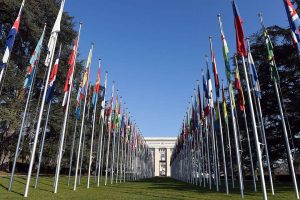29 September 2017: The first Conference of the Parties (COP1) to the Minamata Convention on Mercury considered issues related to reporting, effectiveness evaluation, the financial mechanism, arrangements for a permanent secretariat, compliance and guidance, and guidelines related to technical aspects of the Convention.
The Minamata Convention was adopted on 10 October 2013, and entered into force on 16 August 2017. It bans new and phases out existing mercury mines, contains measures to control air emissions, and regulates the informal sector of artisanal and small-scale gold mining. COP1 took place from 24-29 September 2017, in Geneva, Switzerland.
In opening statements at COP1, Marc Chardonnens, Vice-Minister of Environment, Switzerland, emphasized his country’s commitment to reducing mercury pollution and urged integrating the Minamata Convention into the Basel, Rotterdam and Stockholm (BRS) Conventions “family.” Ibrahim Thiaw, Deputy Executive Director, UN Environment, said the Convention is a building block for the 2030 Agenda for Sustainable Development, and highlighted that it would help countries protect human rights and the environment by improving waste management and switching to cleaner energy and smarter chemicals.
Delegates at COP1 addressed a number of substantive issues that had not been resolved by the intergovernmental negotiating committee. By the close of the week-long meeting, delegates took decisions on the compliance committee and on guidance to the Global Environment Facility (GEF). They also made progress on issues related to establishing reporting cycles and agreeing on guidance on waste thresholds and contaminated sites.
On interim arrangements for the secretariat, delegates agreed it would remain in Geneva under the purview of UN Environment’s Chemicals and Wastes branch until a review of the arrangements at COP2. COP2 will again consider its location and whether it will be independent or integrated with the BRS Secretariat. COP1 also established a specific international programme (SIP) as one part of the financial mechanism, but was unable to agree on the Memorandum of Understanding with the GEF; this decision will also be considered at COP2.
A High-Level Segment provided an interactive platform for delegates to demonstrate political leadership and raise awareness of and support for implementation of the Convention. It was attended by two Heads of State and Government and 80 ministers. In her statement during this segment, Doris Leuthard, President of the Swiss Confederation and Minister for the Environment, Transport, Energy and Communication, noted that the Minamata Convention is a celebration of a global solution and is a success story for multilateralism. She highlighted that the Minamata Convention “was the first multilateral environmental agreement negotiated in the 21st century,” and noted that it builds on elements in other agreements in the chemicals and wastes cluster.
COP2 is scheduled to convene from 19-23 November 2018. [IISD RS Coverage of Minamata COP1] [Messages from the High-Level Segment] [UNEP Press Release on COP1][Minamata Convention Website]

